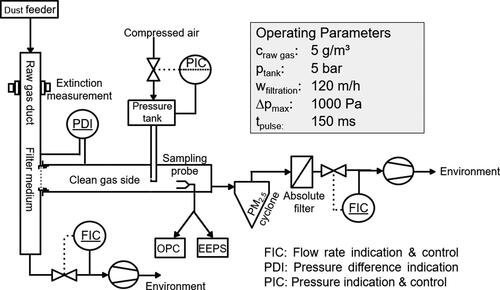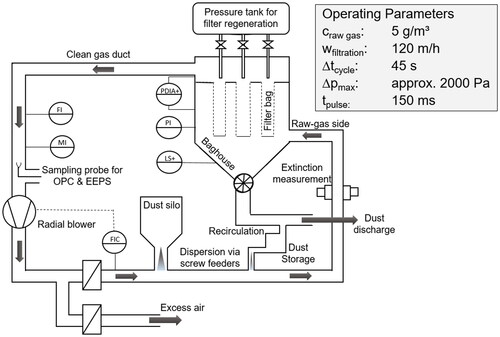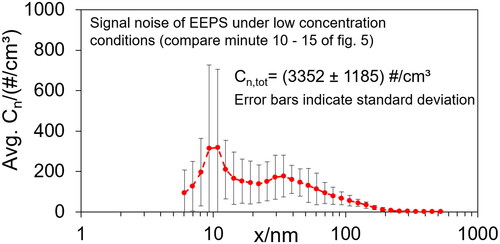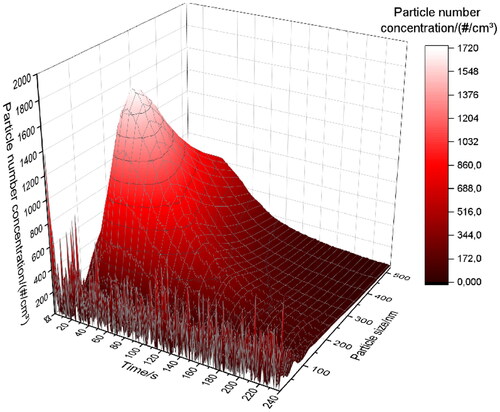Abstract
Baghouse filters are used in a variety of gas cleaning applications in order to lower dust emissions and protect the environment and human health. Regarding health aspects, nanoparticle emissions of pulse-jet cleaned filters are of great interest. Due to the transient emission behavior of the filters, conventional SMPS measurement is not suitable (high sample times). A potential method for the detection of transient particle emission peaks after filter regeneration in the nanometer region is the application of an engine exhaust particle sizer (EEPS). In this study, the size resolved particle emission of pulse jet-cleaned surface filters in a test rig according to DIN ISO 11057 (different filter media) and a small scale baghouse filter measured with an optical spectrometer/particle counter (OPC) (Palas® Promo®2000 with Welas®2100 sensor - measurement range: 200 nm − 10,000 nm) is compared to that measured with an EEPS (TSI® EEPS 3090 - measurement range: 5.6 − 560 nm). Significant nanoparticle emissions could be measured after filter regeneration, which are outside of the OPC measurement range. The size fraction with the highest emission detected by both devices differs greatly and is lower than previously shown by optical detection methods (approx. 200 nm for the EEPS and 300 nm for the OPC measurement). In the overlap region between the two devices above 200 nm, the particle size distributions are in good agreement.
Copyright © 2021 American Association for Aerosol Research
EDITOR:
1. Introduction
Air pollution can have severe impacts on human health. Exposure to increased particulate matter concentrations can cause, e.g., cardiovascular diseases (German National Academy of Sciences Leopoldina Citation2019). Particulate matter concentrations are classified regarding their ability to penetrate the human body and potentially cause harm (e.g., PM2.5 is the fraction of particles that may reach the lung, the PM1 fraction may penetrate deeper into the alveoli). Ultrafine particles are especially dangerous due their ability to enter the blood stream and reach the brain. Industrial facilities are among the highest emitters of particulate matter (Federal Environment Agency (Umweltbundesamt) Citation2009), however the emission of ultrafine particles is in many cases not monitored, as there is no need from a legislative point of view and measurement equipment is expensive (TA Luft, Bundesministerium für Umwelt, Naturschutz und Reaktorsicherheit Citation2002). Nonetheless, regarding health aspects, the nanoparticle emission of industrial facilities is of great interest.
Baghouse filters are state of the art technology for the reduction of particulate matter emissions of technical facilities, where high raw-gas concentrations occur and have to be separated from dust-laden gas streams (e.g., municipal waste incineration, cement plants, etc.) (Dowd and Bump Citation1979). Filter elements (e.g., filter bags) are arranged in baghouses in varying numbers, dependent on the cleaning duty (raw-gas volume flow, concentration, dust-type, etc.) (Schmidt Citation1998). During filter operation, dust is separated at the surface of the filter medium, what leads to the formation of a dust cake with high separation efficiency. Assuming correct filter installation and no major leaks, the emission drops to a zero level with an established dust cake (Bach and Schmidt Citation2007; Kurtz, Meyer, and Kasper Citation2017). In order to enable continuous and economic filter operation, the filter elements are periodically regenerated (e.g., via jet-pulse; Lu and Tsai Citation1998). Regeneration detaches the dust cake from the surface of the medium, leaving it unprotected and prone to particle penetration until a sufficient dust cake is established during operation (Binnig, Meyer, and Kasper Citation2009). This leads to a distinct emission behavior, where transient emissions with high intensity occur after filter regeneration. Dependent on operating conditions and the filter medium, the emission can be only detectable over a timespan of several seconds (Bächler et al. Citation2020). Nanoparticles themselves can pose a challenge in baghouse filtration, as they cause clogging of the filter medium at an increased rate, so that cleaning efficiency is lowered and the residual pressure drop after regeneration increases until stable operation is no longer possible (Cirqueira, Tanabe, and Aguiar Citation2017; Khirouni et al. Citation2020).
Typical measurement technology for emission monitoring includes triboelectrical or gravimetrical measurement of a total clean gas concentration (Wiegleb Citation2016). However, the size resolution of these methods is not sufficient for the measurement of nanoparticles. Optical spectrometers, also typically referred to in literature as optical particle counters (OPC), are based on the measurement of scattered light at a single particle and offer size-resolved particle counts with a high temporal resolution but are limited regarding their detectable size range (lowest detectable particle size approx. 200 − 300 nm). Commonly used measurement technology for the size resolved detection of nanoparticles are scanning mobility particle sizers (SMPS). SMPS systems can be applied successfully in applications with constant concentration conditions, as there is a required sample time for measurement of the total detectable size range. This makes the application of an SMPS difficult due to the transient nature of particle emissions in baghouse filters. Schiller employed a SMPS system for the measurement of nanoparticle emissions of a baghouse filter, however the calculated grade efficiencies were subject to statistical variations and required averaging. The determined MPPS was around 200–300 nm in different publications (Schiller and Schmid Citation2014; Schiller and Schmid Citation2015; Schiller et al. Citation2016). Simon et al. (Citation2014), also measured MPPS of two different surface filter media samples with an SMPS system, where the MPPS of the new filter medium was smaller than 200 nm for a coated filter medium.
In order to measure the transient nanoparticle emission of baghouse filters, a potential solution could be the application of an engine exhaust particle sizer (EEPS). EEPS are commonly used for measurement of engine exhausts or brake wear emissions in the automotive industry (e.g., Burtscher Citation2005; Gerald Liu et al. Citation2009; Wang et al. Citation2006). The measurement principle is based on electrical mobility of charged nanoparticles. In this study, the transient nanoparticle emission of a pulse-jet cleaned surface filter applying an EEPS as aerosol measurement equipment is investigated. The measurement results are compared to a high precision laboratory OPC.
2. Material and methods
2.1. Testing facilities
Filter experiments have been performed in two different experimental facilities. On the one hand, the particle emission under defined conditions in a filter test rig based on DIN ISO 11057 was investigated ().
Filter test rigs are used to obtain operation characteristics, including emission data, differential pressure behavior and filter aging effects of circular flat sheet filter media samples. The filter face velocity was set to 120 m/h according to the norm (DIN ISO 11057:2012-0505 Citation2012). Three different filter media (see chapter 2.4) were investigated under the conditions specified in applying the test dust Pural SB (see chapter 2.3).
Furthermore, experiments under praxis relevant conditions were performed in a small scale baghouse filter with nine filter bags (). The average filter face velocity (total volume flow related to total filter area) was also set to 120 m/h, however the flow conditions in both filters are different. In the baghouse, the volume flow through each filter element varies dependent on their loading state (Simon et al. Citation2010). The gas velocity in the clean gas duct (sampling) amounts to approx. 5.7 m/s. Tank pressure was varied in order to generate different emission levels on the clean gas side. The selected cleaning strategy was “bag-by-bag.” A detailed description of the testing facility can be found in another (open access) publication (Bächler et al. Citation2020).
2.2. Aerosol measurement technology
Two different aerosol measurement devices based on different measurement principles were employed in this study. While the aerosol spectrometer detects light scattered at the single particle, the EEPS is based on classification of particles based on their electrical mobility. Several key specifications are compared in . The high precision laboratory aerosol spectrometer Promo®2000 with welas®2100 sensor can detect particles in a size range from 200 nm to 10 µm. The default settings for the index of refraction was used (n = 1.59 for PSL). Though the employed welas® sensor is a light scattering optical spectrometer (based on the LSAS definition in ISO 21501-11 (Citation2009) contrary to the specification of LSAPC in ISO 21501-44 (Citation2018)) we refer to the device as optical particle counter (or OPC) for simplification in this study, as the two definitions are often used synonymously in literature. The TSI® EEPS 3090 can detect particles ranging from 5.6 to 560 nm. Thus, there is an overlap in the measurement region that enables a comparison of particle counts of the two devices in several size fractions. Another key difference is the maximum concentration of the two devices (Manufacturer specifications: 5 × 105 #/cm³ of Palas® (Citationn.d.) system and 105 − 107 #/cm³ - dependent on the size fraction – for the TSI EEPS). A drawback of the EEPS system is the requirement of a minimum concentration dependent on the corresponding size fractions. Smaller concentrations may be too low to be detected by the electrometer and cannot be distinguished from signal noise.
Table 1. Key specifications of aerosol measurement technology (Source: TSI® Citationn.d.; Palas® Citationn.d.).
displays the threshold size distribution caused by signal noise of the electrometers of the EEPS. In order to be reliably detected by the electrometers, the particle concentration of the corresponding size fraction has to exceed these limits. Especially for smaller particles with an electrical mobility diameter <100 nm, the amount of signal noise is significant. The exemplary data in the figure has been taken from a period of “zero concentration” of one of the measurement runs (compare ).
2.3. Test dust
The employed test dust was Pural SB from the manufacturer Sasol. Pural SB is a free flowing test dust that has little tendency to agglomerate, thus a significant submicron fine dust fraction is available in its dispersed state. The particle size distribution of the test dust obtained via laser diffraction (dispersion via Sympatec QUIXEL with water as working fluid - no sonication - and measurement via Sympatec HELOS), OPC measurement (as described in chapter 2.2) and a conventional SMPS system (TSI SMPS 3082 with long DMA and CPC3756) is displayed in .
demonstrates that the determined size distribution strongly depends on the characterization method and thus, should be carefully evaluated dependent on the application and the capabilities of the measurement instrument. The test dust has a broad size range with a high x50,3 (measured by laser diffraction) of approx. 35 µm. The number based mean diameter x50,0 of the dust is 279 nm for the SMPS measurement and 523 nm for the OPC measurement. Even though the fraction of nano-sized particles below 100 nm is very low, Pural SB is still a reasonable selection for the study due to its wide particle size range, which spans the measurement region of OPC and EEPS and its non-agglomerating behavior and the low adhesive and cohesive properties of the dust (high particle penetration in surface filter tests) (Kurtz, Meyer, and Kasper Citation2017). The use of finer dusts with higher fine dust fractions in the nanometer region, which are generally more cohesive than Pural SB, effectively yields only low nanoparticle concentrations due to incomplete de-agglomeration. These concentrations are potentially below the signal noise of the EEPS which becomes more significant for lower particle diameters.
2.4. Filter media
Three different filter media were employed in the filter test rig order to investigate different emission levels. Key specifications of the filter media are summarized in . Note that filter medium C has an ePTFE membrane laminated on the upstream side, causing low particle emissions. All three media have been investigated in a previous publication regarding their emission level (Bächler, Meyer, and Dittler Citation2019) and have undergone an aging procedure (DIN ISO 11057:2012-0505 Citation2012). The aging procedure consisted of 30 Δp controlled conditioning cycles (Δpmax = 1000 Pa) followed by 1000 Δt controlled cycles (Δt = 30 s) and 60 additional Δp controlled filtration cycles (Δpmax = 1000 Pa).
Table 2. Characteristics of employed filter media.
Regarding the small scale baghouse filter, filter bags made from medium B (regular seams) have been used. The filter bags have been aged prior to the investigation (approx. 400 filtration cycles).
3. Results
3.1. Nanoparticle emissions measured in the filter test rig applying three different filter media
Each of the three filter media samples has been used for a total of three regenerations. As the media samples have been pre-conditioned, high fluctuations of peak intensity/particle emissions for each regeneration are not to be expected. The differential pressure profile and the measured particle number concentrations for medium B are shown in .
Figure 5. Detected Number concentration profile in the filter test rig for all measurement instruments for filter medium B for all size fractions (top) and only the higher size fractions with a particle diameter >90 nm (bottom).
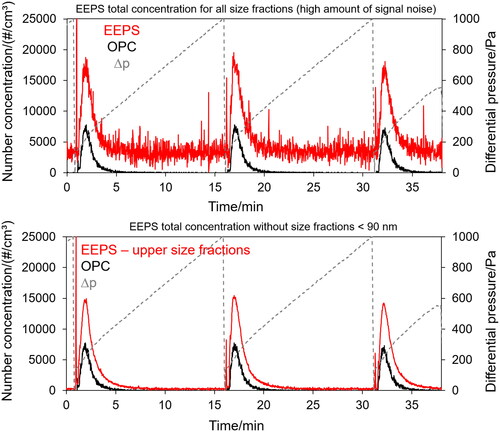
Shortly after the jet pulse, particles penetrate the filter medium and the measured particle emission increases significantly in the form of an emission peak. The emission peak from the EEPS measurement is significantly higher (factor >2), which indicates a high number of nanoparticles outside of the measurement range of the scattered light based aerosol spectrometer which are not detected. After a dust cake is formed, the emission decreases to a zero level according to the OPC measurement. This behavior is not displayed correctly by the detected total concentration of the EEPS, as the total clean gas concentration is below the total threshold concentration of approx. 3000 #/cm³ and signal noise is predominantly detected during the filtration phase. When neglecting smaller size fractions and only considering sizes >90 nm, the total particle concentration still does not drop below approx. 150 #/cm³, however the overall concentration evolution detected by EEPS and OPC is qualitatively in good agreement.
shows the temporal and size resolved concentration profile of the third particle emission peak shown in , demonstrating the capabilities of the measurement instrument and the evolution of the particle size distribution over the course of the emission peak. The lower size fractions below 100 nm are dominated by signal noise and no significant particle number concentrations are detected, as would be expected regarding the size distribution of the test dust ().
To give a comparison between the three different filter media, the last of the three emission peaks for each run and the corresponding average particle size distribution is displayed in . As a neutral reference for “zero concentration,” the seemingly present size distribution resulting from signal noise during the filtration phase is also shown in the figure (compare ).
Figure 7. Last emission peak of measurement (total concentration) for EEPS and OPC and average particle size for all three filter media. The maximum of the emission peak has been shifted to 1 min time. Signal noise in the PSD has been taken from the filtration phase (period of zero concentration according to OPC measurement). Note that the EEPS classifies particles based on electrical mobility while OPC measurement yields optical particle diameters.
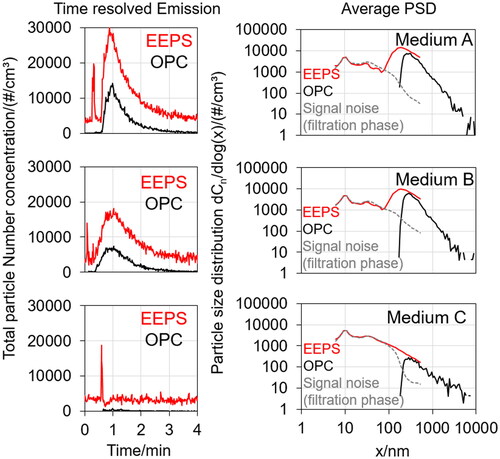
The overlap between OPC and EEPS measurement range shows higher amounts of particles in the EEPS measurement. The largest deviations occur in the lowest size bins of the OPC, where counting efficiency drops significantly and almost no particles are detected. The EEPS measurement indicates the real behavior, where significant amounts of nanoparticles can penetrate the filter medium and are detected on the clean gas side. The size fraction with the largest particle emission (by number) is around 200 nm, instead of the 300 nm resulting from the OPC measurement. The agreement of the curves also demonstrates that electrical mobility diameter and optical particle diameter correspond well for the employed test dust. The filter media display three particle emission levels. While the overall emission level and clean gas PSD of medium A and B is quite similar, medium C (membrane filter medium) has a very low emission level due to the high separation efficiency of the membrane. Here, the total particle emission measured by the EEPS can only be barely distinguished from signal noise, as the threshold concentration (about 1000 − 3000 #/cm³) is not significantly exceeded. However, the difference in PSD between signal noise during the filtration phase and shortly after filter regeneration (emission peak) clearly shows particles in similar size fractions as the other two filter media. By combining the size distributions both measurement devices, the characterization of the complete clean gas PSD can be greatly enhanced.
3.2. Nanoparticle emissions measured in the small scale baghouse filter at two different tank pressures for filter regeneration
Another set of experiments was performed in a small scale baghouse filter in order to demonstrate the relevance of nanoparticle emissions during more realistic operation conditions. The installed filter bags have been aged for approx. 400 initial cycles to grant a stable emission level with a low emission contribution of the seams of the filter bag (clogging effect). shows the nanoparticle emission at two different tank pressures for a cycle time of 45 s. The cycle time has been selected to grant sufficient time for cake formation in between filter regenerations to investigate the capability to measure the emission peak as well as the baseline “zero” concentrations during the filtration phase. Similar to the filter test rig, the detected particle number concentration is significantly higher for the EEPS, indicating high numbers of particles outside of the OPC detectable size range. Due to the higher flow velocity in the downflow pipe on the clean gas side (5.7 m/s opposed to 3.3 cm/s in the filter test rig), the duration where an emission is detected (approx. 10 s) is way shorter, making size resolved real time measurement across all size fractions with a single SMPS system not suitable.
Figure 8. Emission data measured in the small scale baghouse filter at two different tank pressures.
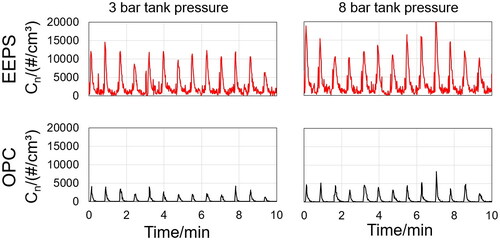
An increase in tank pressure leads to higher emissions (Kurtz, Meyer, and Kasper Citation2016) and (in some cases) to a continuous emission (emission contribution of de-clogging of seams due to higher pulse intensities). However, the baseline emission in between regenerations is still very low and below the threshold concentration of the EEPS.
The particle size distribution of an exemplary emission peak is displayed in for both tank pressures. The different concentration levels are clearly detected by both devices. The lower size bins of the OPC strongly deviate from the EEPS measurement. In the overlap region between the two devices, the curves are in agreement.
Figure 9. Exemplary emission peak (total concentration) for EEPS and OPC at two different tank pressures and corresponding average particle size distributions. Note that EEPS measurement yields electrical mobility diameters and OPC measurement yields optical diameters (different measurement principles).
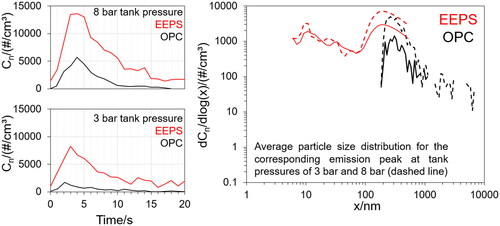
4. Conclusions
An engine exhaust particle sizer (EEPS) has been used to determine the time and size resolved particle emission for pulse-jet cleaned surface filters in two different testing facilities – a filter test rig and a small scale baghouse filter. The measured particle size distributions and total concentrations were compared to a high precision laboratory aerosol spectrometer, as there is an overlap of the two devices in the region of 200 − 500 nm and OPC technology has been used in different publications in order to characterize the particle emission behavior of pulse-jet cleaned filters (e.g., Bächler, Meyer, and Dittler Citation2019).
Three different types of filter media could be distinguished in a filter test rig by both devices regarding their particle emission level. Experiments in the small scale baghouse filter showed the requirement of the temporal and size resolved EEPS measurement due to much shorter durations (several seconds) where particle emissions can be detected. The difference in particle emission of two tank pressures could be confirmed by the EEPS measurement (higher emissions at increasing tank pressures).
The particle emission peak after filter regeneration exceeded the threshold concentration of the EEPS what indicates a significant nanoparticle emission outside of the OPC measurement range. The highest concentrations were obtained in a size fraction around 200 nm for the EEPS and 300 nm for the OPC measurement. The particle size distributions of OPC and EEPS correlated well in the overlap region of the two devices above 200 nm. However, at particle sizes around 200 nm, the counting efficiency of the OPC drops significantly and the detected concentrations are significantly lower compared to EEPS measurement. Thus, the lower size fractions of the OPC should be carefully evaluated regarding their accuracy in filter emission measurement.
Below 100 nanometers, the size distribution of the test dust does not include significant numbers of particles in the corresponding size range so that the threshold concentration of the EEPS is not exceeded. High separation efficiencies due to the diffusion mechanism would be expected in this size fraction (Brown Citation1993). The minimum concentration requirement is one of the main limitations of the EEPS in the characterization of the transient particle emission behavior of pulse-jet cleaned filters. During the filtration phase with a sufficiently established dust cake, very low particle concentrations are realized that cannot be distinguished from signal noise of the device. The OPC measurement and the upper size classes of the EEPS correctly show the drop to (almost) zero emission. Additionally, the particle emission of highly efficient membrane filter media might lie below the threshold concentration, as no significant difference of the total concentration was detected and the nanoparticle emission was only noticeable in the PSD. More cohesive dusts compared to the employed test dust (Pural SB) may also pose a challenge, as they typically result in lower emissions (Kurtz, Meyer, and Kasper Citation2017; Sobich and Kasper Citation2018).
The results demonstrate the significance of nanoparticle emissions below 300 nm for pulse-jet cleaned filters. The EEPS complemented the OPC measurements for smaller size fractions and led to a better understanding of the quantitative high emissions right after the pulse. As both measurement techniques have shortcomings, their combined advantages helped to better understand the transient behavior of pulse jet-cleaned filters what may be considered regarding the development of surface filter media. Employing size resolved online aerosol measurement technology for industrial emission monitoring (instead of gravimetrical measurement of total dust emissions where submicron particles are insufficiently accounted for) and/or considering the emission contribution of submicron particle emissions in legislative limits may improve process monitoring and improve environmental protection from harmful (nano-)particle emissions. Further research will deal with methodology regarding measurement of nanoparticle emissions of pulse – jet cleaned filters employing conventional SMPS systems at constant voltages to serve as a classifier. This has the advantage that no threshold concentration has to be exceeded for nanoparticle measurement.
| Nomenclature and abbreviations |
| EEPS | = | engine exhaust particle sizer |
| OPC | = | optical particle counter |
| PSD | = | particle size distribution |
| SMPS | = | scanning mobility particle sizer |
| CPC | = | condensation particle counter |
| DMA | = | differential mobility analyzer |
| Cn | = | particle number concentration |
| PM | = | particulate matter |
| Qi | = | cumulative size distribution (i = 0 – number based; i = 3 volume/mass based) |
| x50,i | = | mean particle diameter (i = 0 – number based; i = 3 volume/mass based) |
| PSL | = | polystyrene (spherical) particles |
| n | = | index of refraction |
Acknowledgments
We acknowledge the collaboration of Jürgen Spielvogel and Stephane Percot from TSI for providing measurement equipment. We acknowledge the collaboration of Akin Filiz and Vanessa Löschner for their help in conducting the experiments.
Declaration of interests
The authors declare that they have no known competing financial interests or personal relationships that could have appeared to influence the work reported in this article.
References
- Bach, B., and E. Schmidt. 2007. Influence of leaks in surface filters on particulate emissions. J. Hazard. Mater 143 (3):673–6. doi:10.1016/j.jhazmat.2007.01.093.
- Bächler, P., J. Meyer, and A. Dittler. 2019. Characterization of the emission behavior of pulse-jet cleaned filters using a low-cost particulate matter sensor. Grdl. 79 (11-12):443–50. doi:10.37544/0949-8036-2019-11-12-49.
- Bächler, P., J. Szabadi, J. Meyer, and A. Dittler. 2020. Simultaneous measurement of spatially resolved particle emissions in a pilot plant scale baghouse filter applying distributed low-cost particulate matter sensors. J. Aerosol Sci. 150:105644. doi:10.1016/j.jaerosci.2020.105644.
- Binnig, J., J. Meyer, and G. Kasper. 2009. Origin and mechanisms of dust emission pulse-jet cleaning filter media. Powder Technol. 189 (1):108–14. doi; . doi:10.1016/j.powtec.2008.06.012.
- Brown, R. C. 1993. Air filtration – An integrated approach to the theory and applications of fibrous media. Pergamon Press, Oxford.
- Bundesministerium für Umwelt, Naturschutz und Reaktorsicherheit. 2002. Erste Allgemeine Verwaltungsvorschrift zum Bundes–Immissionsschutzgesetz (Technische Anleitung zur Reinhaltung der Luft – TA Luft). GMBl. Heft 25-29:511–60.
- Burtscher, H. 2005. Physical characterization of particulate emissions from diesel engines: a review. J. Aerosol Sci. 36 (7):896–932. doi:10.1016/j.jaerosci.2004.12.001.
- Cirqueira, S. S. R., E. H. Tanabe, and M. L. Aguiar. 2017. Evaluation of operating conditions during the pulse jet cleaning filtration using different surface treated fibrous filters. Process Saf Environ. 105 (2017):69–78. doi:10.1016/j.psep.2016.10.010.
- DIN ISO 11057:2012-05. 2012. Emissionen aus stationären Quellen – Prüfverfahren für die Charakterisierung des Filtrationsverhaltens abreinigbarer Filtermedien (ISO 11057:2011). Beuth Verlag
- Dowd, W. W., and Bump, D. L. 1979. A pulse type baghouse designed for use on a cement clinker cooler. J. Air Pollut. Control. Assoc. 29 (1):16–8. doi:10.1080/00022470.1979.10470741.
- Federal Environment Agency (Umweltbundesamt). 2009. Trends in air quality in Germany. Accessed October 8, 2021. https://www.umweltbundesamt.de/sites/default/files/medien/publikation/long/3943.pdf
- Gerald Liu, Z., V. N. Vasys, M. E. Dettmann, J. J. Schauer, D. B. Kittelson, and J. Swanson. 2009. Comparison of strategies for the measurement of mass emissions from diesel engines emitting ultra-low levels of particulate matter. Aerosol Sci. Technol 43 (11):1142–52. doi:10.1080/02786820903219035.
- German National Academy of Sciences Leopoldina. 2019. Clean air. Nitrogen oxides and particulate matter in ambient air: Basic principles and recommendations. Halle (Saale), Accessed October 8, https://www.leopoldina.org/uploads/tx_leopublication/2019_Leo_Stellungnahme_Saubere_Luft_en_web_05.pdf on 03/20/2020.
- ISO 21501-1. 2009. Determination of particle size distribution — Single particle light interaction methods — Part 1: Light scattering aerosol spectrometer (ISO 21501-1). Beuth Verlag.
- ISO 21501-4. 2018. Determination of particle size distribution — Single particle light interaction methods — Part 4: Light scattering airborne particle counter for clean spaces (ISO 21501-4). Beuth Verlag.
- Khirouni, N., A. Charvet, D. Thomas, and D. Bémer. 2020. Regeneration of dust filters challenged with metallic nanoparticles: Influence of atmospheric aging. Process Saf Environ 138 (2020):1–8. doi:10.1016/j.psep.2020.02.040.
- Kurtz, O., J. Meyer, and G. Kasper. 2016. Influence of filter operating parameters on fine dust emissions from pulse-cleaned filter bags. Chem. Eng. Technol. 39 (3):435–43. doi:10.1002/ceat.201500340.
- Kurtz, O., J. Meyer, and G. Kasper. 2017. The contribution of small leaks in a baghouse filter to dust emission in the PM2.5 range – A system approach. Particuology 30:40–52. doi:10.1016/j.partic.2016.08.001.
- Lu, H. C., and C. J. Tsai. 1998. A pilot-scale study of the design and operation parameters of a pulse-jet baghouse. Aerosol Sci. Tech. 29 (6):510–24. doi:10.1080/02786829808965587.
- Palas®. n.d. Product specifications. Accessed October 8, 2021. https://www.palas.de/product/promo2000
- Schiller, S., Hellmich, C. and Schmid, H. J. 2016. Evaluation of filtration processes using precoat materials. Chem. Eng. Technol. 39 (3):491–8. doi:10.1002/ceat.201500385.
- Schiller, S., and H. J. Schmid. 2014. Ultrafine dust filtration using precoat materials considering the influence of filter media. Chem. Eng. Technol. 37 (6):1009–20. doi:10.1002/ceat.201300856.
- Schiller, S., and H. J. Schmid. 2015. Highly efficient filtration of ultrafine dust in baghouse filters using precoat materials. Powder Technol. 279:96–105. doi:10.1016/j.powtec.2015.03.048.
- Schmidt, E. 1998. Abscheidung von Partikeln aus Gasen mit Oberflächenfiltern. Fortschritt-Berichte der VDI-Zeitschriften, Reihe 3 (546). Düsseldorf: VDI Verlag.
- Simon, X., D. Bémer, S. Chazelet, and D. Thomas. 2014. Downstream particle puffs emitted during pulse-jet cleaning of a baghouse wood dust collector: Influence of operating conditions and filter surface treatment. Powder Technol 261:61–70. doi:10.1016/j.powtec.2014.04.028.
- Simon, X., D. Bémer, S. Chazelet, D. Thomas, and R. Régnier. 2010. Consequences of high transitory airflows generated by segmented pulse-jet cleaning of dust collector filter bags. Powder Technol 201 (1):37–48. doi:10.1016/j.powtec.2010.02.036.
- Sobich, S. M., and G. Kasper. 2018. Baghouse filtration: A praxis-relevant media parameter to determine an emissions level of a pulse-jet cleanable filter. Paper presented at Filtech 2018, Cologne, Germany.
- TSI®. n.d. Product specifications. Accessed October 8, 2021. https://tsi.com/products/particle-sizers/particle-size-spectrometers/engine-exhaust-particle-sizer-spectrometer-eeps-3090/
- Wang, J., J. Storey, N. Domingo, S. Huff, J. Thomas, and B. West. 2006. Studies of diesel engine particle emissions during transient operations using an engine exhaust particle sizer. Aerosol Sci. Technol 40 (11):1002–15. doi:10.1080/02786820600919408.
- Wiegleb, G. 2016. Gasmesstechnik in Theorie und Praxis. Springer Vieweg, Wiesbaden. doi:10.1007/978-3-658-10687-4.

